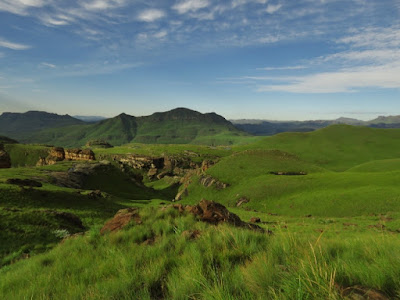“THE ABSOLUTE SIMPLICITY, THAT’S WHAT I
LOVE. WHEN YOU’RE HIKING THE WILDERNESS YOUR MIND IS CLEAR AND FREE FROM ALL
CONFUSIONS. YOU HAVE FOCUS. AND SUDDENLY THE LIGHT BECOMES SHARPER, THE SOUNDS
ARE RICHER AND YOU’RE FILLED WITH THE DEEP, POWERFUL PRESENCE OF LIFE.”
UNKNOWN
DRAKENSBERG MOUNTAINS FIRES
Plant life in the Drakensberg is affected not only by altitude, vegetation regions, and climate, but also by fire. Grass fires are common in the Drakensberg, especially in the winter and early spring months and they have a profound effect on the vegetation.
It must be remembered, first of all, that although grass fires are much more common today than in the early days, they are not entirely man-made, and have undoubtedly been known in the Drakensberg for thousands, if not millions, of years. Fires are often started by lightning and by sparks from rocks rolling down the mountain side. The vegetation has had to learn to adapt itself to these periodic fires.
At the same time it must be admitted that with the advent of man fires are much more frequent today than they were in the olden days. Undoubtedly some of our mountain species are threatened by these raging fires which sweep down, year after year, from the heights.
On a sloping piece of ground there was not a single Erica to be seen. It would seem that the plant literally disappears with frequent burning. When not burned for a number of years, the slope will be covered with masses of Erica woodii flowers, a great sheet of magenta-pink.
Erica cerinthoides provides another interesting example. It is found sparsely throughout the Drakensberg, but the plants never reach a height of more than 0,25 metres. In the Wild Flower Garden in the Giant’s Castle Reserve, however, where the plants are protected from fires, there are two bushes of this Erica which flower profusely every year, and which have reached a height of over a metre. But you will notice one interesting phenomenon. Those plants in the wild, which are subject to periodic burning, bear larger flowers, and of a brighter red, than those which are never burned.
Proteas, too, are adversely affected by fires. Protea roupelliae grows in grasslands on the slopes of the Little Berg, but it also grows in rocky outcrops and on the cave sandstone plateau. Its thick bark protects it to some extent from the damage caused by fires, but you will find that those trees growing in rocky outcrops, where the grass cover is thin, are far finer specimens than those growing in the grasslands, where the heat from the fire is so much more intense. Magnificent stands of Protea roupelliae can be found growing on massive outcrops of cave sandstone, where few fires could ever reach them.
Protea multibracteata, with its thick, corky bark, is able to withstand the effect of fires, but if the fire comes late in the season, when the sap is flowing freely, the trees often have burst stems, due to the fact that the sap vaporizes and, being confined, bursts the stem.
This is not the full story, however. Occasional fires do act as a regenerating factor, and you will notice that in those areas of the Drakensberg which are subject to occasional fires, the flush of early spring flowers is far finer than on unburnt areas, where the grasses have grown coarser and the veld flowers are smothered. The brave show of new flowers in the blackened veld of early spring, after a fire, is a well-known sight in the Drakensberg.
Unquestionably, too, the germination of some seeds is stimulated by fire. The silver wattle is a well-known example of this. Protea subvestita is another. The two other Protea tree-species, Protea roupelliae and Protea multibracteata, protect themselves partly against fire by means of their thick bark. Protea subvestita lacks this, and the trees protect themselves partly by growing much more thickly together than in the case of the other two species. But the tree also ensures its survival in much the same way that the wattle does. You will often see a lone Protea subvestita blackened and killed by the fire, but around it are literally hundreds of young plants growing from seed stimulated by the very fire which killed the parent plant. The heat of the fire causes the hard epidermis of the seed to crack, in this way allowing moisture to reach the embryo and so start germination.
In the Drakensberg plants have adopted many methods which enable them to survive fires. That is why you will so often find Ericas growing in south-facing rock gullies, where the fires rage less fiercely than on north-facing slopes. Bulbous plants are more easily able to survive a fire than plants equipped with roots, especially shallow roots. This is undoubtedly one reason why the Drakensberg is so rich in flowers from the Liliaceae, Iridaceae, and Amaryllidaceae families, most of which have bulbs or corms.
We may conclude then, that many plant species in the Drakensberg are gravely endangered by mountain fires, that many have adapted themselves to withstand the effects of fires, but that occasional fires are beneficial, acting as a regenerating factor, clearing out the thickly-matted old grasses and dead undergrowth, and stimulating seed germination.
Never, but never, start a fire anywhere in the Drakensberg Wilderness when on a hiking trip!
We as hikers, explorers, and adventurers have the absolute duty to respect and protect our Wildernesses. Nobody else will do it for us. Take ownership!
The End.
Safe Hiking.
References and Acknowledgements
From the book – Mountain Splendour – RO Pearce
Photos: ©Willem Pelser
Compiled by: Willem Pelser














